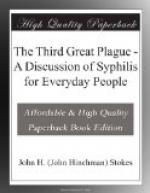+Importance of Prompt and Expert Medical Advice.+—The recognition of syphilis in the primary stage does not follow any rule of thumb, and is as much an affair for expert judgment as a strictly engineering or legal problem. In the great majority of cases a correct decision of the matter can be reached in the primary stage by careful study and examination, but not by any slipshod or guesswork means. To secure the benefit of modern methods for the early recognition of syphilis those who expose themselves, or are exposed knowingly, to the risk of getting the disease by any of the commoner sources of infection, should seek expert medical advice at once on the appearance of anything out of the ordinary, no matter how trivial, on the parts exposed. The commoner sources of infection may be taken to be the kissing of strangers, the careless use of common personal and toilet articles which come in contact with the mouth especially,—all of which are explained later,—and illicit sexual relations. While this by no means includes all the means for the transmission of the disease, those who do these things are in direct danger, and should be warned accordingly.
+Modern Methods of Identifying an Early Syphilitic Infection.+—The practice of tampering with sores, chafes, etc., which are open to suspicion, whether done by the patient himself or by the doctor before reaching a decision as to the nature of the trouble, is unwise. An attempt to “burn it out” with caustic or otherwise, which is the first impulse of the layman with a half-way knowledge and even of some doctors, promptly makes impossible a real decision as to whether or not syphilis is present. Even a salve, a wash, or a powder may spoil the best efforts to find out what the matter is. A patient seeking advice should go to his doctor at once, and absolutely untreated. Then, again, irritating treatment applied unwisely to even a harmless sore may make a mere chafe look like a hard chancre, and result in the patient’s being treated for months or longer for syphilis. Nowadays our first effort after studying the appearance of the suspected lesion is to try to find the germs, with the dark-field microscope or a stain. Having found them, the question is largely settled, although we also take a blood test. If we fail to find the germs, it is no proof that syphilis is absent, and we reexamine and take blood tests at intervals for some months to come, to be sure that the infection has not escaped our vigilance, as it sometimes does if we relax our precautions. In recognizing syphilis, the wise layman is the one who knows he does not know. The clever one who is familiar with everything “they say” about the disease, and has read about the matter in medical books into the bargain, is the best sort of target for trouble. Such men are about as well armed as the man who attacks a lion with a toothpick. He may stop him with his eye, but it is a safer bet he will be eaten.




